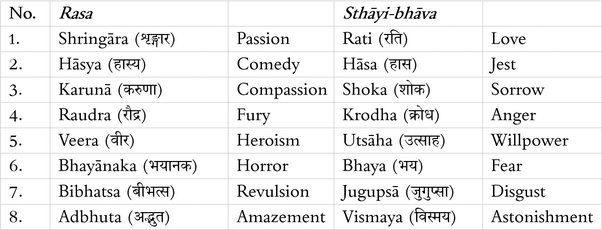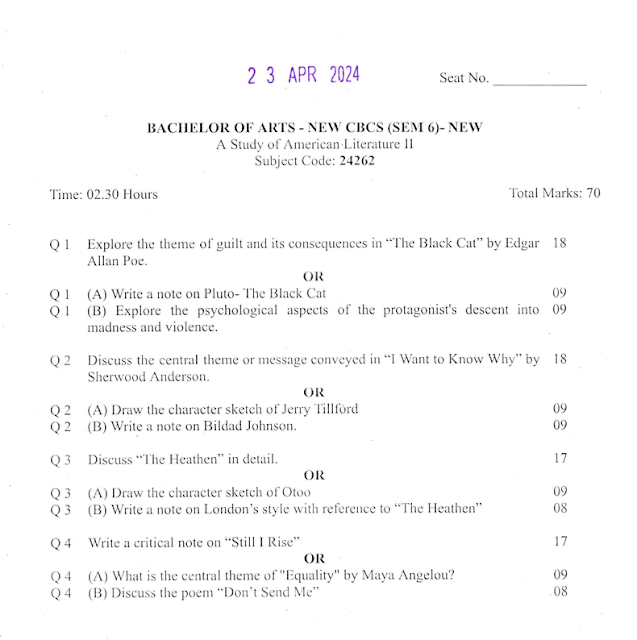⇰ Indian Poetics
"No composition can proceed without rasa."
In the growth and development of Sanskrit Literary Criticism we distinguish two distinctive stages: the first is represented by the early writerson poetics who preceded Anandavardhana, and the second by later aestheticianslike Abhinavagupta who made outstanding contributions to the revision of Indianaesthetics.
Indian poetics refers to the study and creation of poetry and literary criticism in the Indian subcontinent. It includes the traditional forms of poetry found in ancient texts like the Vedas and epics, as well as modern poetry written in various Indian languages. Indian poetics also includes concepts such as rasa (emotion or sentiment), alankara (ornamentation or figurative language), and dhvani (suggestion or implication) that are used to create and analyse poetry.
Different schools of Literature (સંપ્રદાય) :
- રસ - emotions, sentiment (by Bharat)
- ધ્વનિ -Implication (by Anand Vardhan)
- અલંકાર - Principle of figurativeness (by Bhamah)
- રીતી - mode of expression (by Vaman)
- વક્રોક્તિ - principle of deviation (by Kuntaka)
- ઓચિત્ય -Propriety (by Shemendra)
Before understanding Rasa theory it is necessary to understand about Bhav(emotion).
According to Bharat, Bhava (emotional state) and Rasa (aesthetic flavor) are interdependent. Artists, musicians, singers, composers, or theater performers should have a clear understanding of the sthayi bhava (primary emotion) and the corresponding rasa they intend to evoke in their audience. This understanding is crucial for achieving the desired emotional impact or siddhi, through the process of Rasotpatti (the emergence of aesthetic flavor). Therefore, it is essential for artists to be knowledgeable about both Bhava and Rasa to create a successful performance.
Some Gujarati lines from notes of Vinod Joshi Sir's Lecture.
- ભાષા છે એ ધ્વનિ છે પણ ધ્વનિ ભાષા ન પણ હોય ભાષા નેસર્ગિક નથી ભાવ નૈસર્ગીક છે ભાવની અભિવ્યક્તિ માટે ભાષાનું માધ્યમ ઉપયોગમાં લેવાય છે.
- ભાષાએ ભાવોને ઘાટ આપ્યો જે માટે જુદી જુદી કલાઓ આવી તેમાંની એક કલા એટલે સાહિત્ય.
- સાહિત્ય ભાવ સૃષ્ટિને વિચાર સૃષ્ટિમાં બદલે છે. સમજવું એટલે ભાષા અને અનુભવવું એટલે ભાવ.
- અનુભવ્યું હોય એ રીતે અભિવ્યક્ત ન થઈ શકાય.
- ભાવ જગત અને ભાવ એક જ એવી વસ્તુ છે જેનું સામાન્યીકરણ (Generalization) થઈ શકે.
- સાહિત્ય એ ભાવનું સાર્વત્રિકરણ કરે છે.
- આપણું ઉત્તરાણ ભાવ જગત પરનું છે.
- (Language is sound but sound may not be language Language is not natural Thought is natural The medium of language is used to express thought.
- Language gave shape to values for which different arts came into existence, one of which is literature.
- Literature transforms value creation into thought creation. Understanding is language and feeling is value.
- Cannot be expressed as experienced.
- Bhav Jagat and Bhav are only one thing that can be Generalized. Example: Tears for Pain, Smile for Happiness
- Literature universalizes that spirit.
- Our response is to the Bhav Jagat.)
⇰ Rasa Theory
Rasa is a Sanskrit term that refers to the emotional essence evoked by a work of art, such as a poem, play, or music.
It is the overall feeling or mood that a work of art creates in the audience or reader, and is considered an essential aspect of Indian aesthetic theory. The concept of rasa is closely tied to the idea of bhava, which refers to the emotional states or moods that are portrayed in a work of art. In Indian poetics, the creation of rasa is considered the ultimate goal of artistic expression.
The term ‘rasa’ literally means taste or delight in, and is employed to denote the essence of poetry; the peculiar aesthetic experience that art gives us.
Different Rasas Bharat in Nätyasastra emphasizes the fact that the object of art is pleasure . No doubt , art can be didactic of full of philosophical speculations , but all must come through a medium that is pleasurable .
The doctrine that rasa is the essence of art begins from first century A.D. with Bharata . " No composition can proceed without rasa , " claims Bharata in his famous treatise on dramaturgy , Natyasastra .
In the chapter called Rasadhyaya in Natyasastra VI Bharata explains :
' na hi rasadrte kascid arthah pravartate '(न हि रसद्रते कस्सिद अर्थः प्रवर्तते ' ।)
Meaning, "every activity ( on the stage ) is aimed at the creation or generation of rasa." https://www.scribd.com/document/603930613/Unit-4
Bharat's rasa consideration is about drama.
It is derived from the Sanskrit word for "Rasa" (essence).
In the sixth chapter of Natyashastra of Bharatamuni, Rasa Mimansa is done.
- વિભાવ - Vibhav (Determinants)
- અનુભાવ - Anubhav (Consequences)
- વ્યભિચારી ભાવ/ સંચારી ભાવ -Vyabhicaribhav (Transitory feelings)
- સયોગ
The realization of Rasa is said to result from the union of three interrelated elements - Vibhava, Anubhava and Vyabhichari Bhava and also the permanent mode called Sthayibhava.
Vibhava is the root ( karana ) , the chief motivating reason being termed as alambana vibhava and , the environmental factors that are supplementary causes termed as uddipana vibhava ( excitant ) .
Anubhava is the resultant physical response through action , word and facial expression that follows ( anu ) , as the impact of the vibhava.
Vibhava refers to the primary cause or motive for an emotion, while anubhava is the physical response that follows, such as action, words, and facial expressions.
There are two types of vibhava:
Alambana vibhava, which is the chief motivating factor.
Uddipana vibhava, which are the supplementary environmental factors that contribute to emotion.
The thirty-three (33) Vyabhichari bhava (also referred to as sanchari bhava), are momentary , fleeting emotions based on emotional states of the mind. Numerous such emotions pursue one after the other, one replacing the other, intensification the sthayi bhava at each stage, till in conclusion the sthayibhava is established and there is 'Rasanubhava'. Rasanubhava just music a procession of notes in certain combinations reveals a characteristic melodic whole or raga; in the same way, it seems that the demonstration of bhavas reveals rasa as an aesthetic whole.
(Note: The meaning of the word Vyabhicharibhav (વ્યભિચારીભાવ) is different in the context of Rasa theory.)
Vyabhicharibhav (વ્યભિચારીભાવ) also known as a Sancharibhav (સંચારી ભાવ).
વિભાવ + અનુભાવ + સંચારી ભાવ = સંયોગ
સમાન પ્રમાણમાં સંયોગથી રસ નિષ્પતિ થાય છે.
(સમ+યોગ)
ઉદાહરણ (Detailed example 1) :
⇨ શાકુંતલ (કૃતિ)
⇨ દુષ્યંત - શકુંતલા (કૃતિના મુખ્ય પાત્રો)
⇒ વિભાવ = જેના આધારે રસ નિષ્પતિ થાય તે વિભાવ.
→ આલંબન વિભાવ = પાત્ર - દુષ્યંત, શકુંતલા→ ઉદ્દીપક વિભાવ = પરિસ્થિતિ - ભ્રમર, વૃક્ષો
⇒ અનુભાવ = પ્રતિક્રિયા, શકુંતલાએ પ્રતિક્રિયા આપી એ
⇒ સંચારી ભાવ = આવે અને ક્ષણિકમાં જતો રહે તે - શકુંતલા ભ્રમર થી ડરે એ
⇒ સંયોગ = પ્રણય રસ
Translation in English : Detailed example 1
⇨ Shakuntal (literary work)
⇨ Dushyant - Shakuntala (main characters of the work)
⇨ Dushyant - Shakuntala (main characters of the work)
⇒Vibhava = Vibhava on the basis of which interest is realized.
→ Alamban Vibhava = Character - Dushyanta, Shakuntala
→Uddipaka Vibhava = situation - Bumblebee, trees
⇒Anubhava = reaction Shakuntala reacted
⇒Sanchari Bhav = comes and goes in a moment-Shakuntala scares Bumblebee
⇒Sanyog = Romantic interest.
Example 2:
પોઢેલા પિયુના by રામનારાયણ વિ.પાઠક 'શેષ'
" પોઢેલા પિયુના પરે ઝળુંબતી કો રંગભીની વધૂ,
વિશ્રંભે ચૂમવા ચહે નીરખીને એકાન્ત આવાસનું,
ઓચિંતાં પિયુનેન ત્યાં ઊઘડતાં છાયે મુખે લાલિમા,
થંભ્યો અધ્ધર ઊગતો ક્ષિતિજથી, તેવો દીસે ચન્દ્રમા! "
વિભાવ:- પતિની નિદ્રા અને ઘરનું એકાંત
અનુભાવ:- પતિને ચુમવાનો ભાવ
વ્યભિચારીભાવ/સંંચારી ભાવ :- ઓચિંતું પતિનું જાગી જ્વું
Bharat divided the Rasa under eight types (ashtarasa) and gives the resultant Bhava which gives rise to the rasa. These are known as Sthayi Bhava or pervading stable emotion . They are rati ( love ) , utsaha ( heroism ) , krodha ( anger ) , hasa ( mirth ) , bhaya ( fear ) , shoka ( grief ) , jugupsa ( disgust ) , and vismaya ( wonder ) . The resultant eight Rasa are sringara ( amorous ) , karuna ( pathetic ) , raudra ( furious ) , bhayanaka ( horrific ) , hasya ( humorous ) , bibhatsa ( repugnant ) , vira ( valorous ) , and adbhutat ( wondrous ) .
Afterwards, Abhivangupta introduced a ninth rasa called Śāntam which denotes the peace or tranquillity.he mentions the ninth rasa as 'Shanta' rasa. There are evidence of support for the ninth rasa.
"Evam nava rasa drsta natyagnerlaksananvita". Shanta rasa is experienced when all calm pervades.
Shanta rasa develops calmness of mind and a feeling of relaxation . Shanta rasa arises from the desire to secure liberation of the self, which leads to the knowledge of truth and is connected with the highest happiness. Whether Bharat in Natyasastra has listed eight or nine rasas is controversial. But it is widely accepted by scholars that santa rasa is a later addition and henceforth it forms an immortal part of the rasa theory.
The rasas correspond to sthayibhavas (the dominant or permanent emotions)
According to Indian aesthetic theory, there are nine (9) primary rasas, or emotional flavors, that can be evoked in a work of art. These include:
शृङ्गार करुण वीर रौद्र हास्य भयानका ।बिभत्साद्भुत् शान्तश्च नव नाट्ये रसास्मृता: ॥
(- Abhinavgupta)
- Shringara (erotic or romantic)
- Hasya (comic)
- Karuna (pathetic or compassionate)
- Raudra (angry or violent)
- Veera (heroic)
- Bhayanaka (fearful or terrifying)
- Bibhatsa (disgusting or revolting)
- Adbhuta (wondrous or miraculous)
- Shanta (peaceful or tranquil)
The series of videos are available on YouTube Playlist.(Channel: English-MKBU)
(Words 1426, Images 04, Video 01)
- Please comment below if this blog is useful for you.






No comments:
Post a Comment